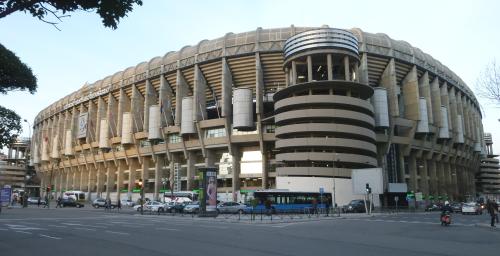
Real Madrid president Florentino Pérez is not one for modest ambitions. While his galácticos have to bring successes on the pitch, he himself is busy to create legacy by turning Estadio Santiago Bernabéu into one of the world’s most modern arenas.
These plans were already presented last year, but recently received a firm push when a judge lifted a block on the project that had previously been put there to protect the rights and interests of affected parties.
Main objective of the project is, of course, to further exploit the commercial possibilities of the Bernabéu, which will be transformed in a place where people can eat, drink, and sleep 24 hours a day.
Most prominent is the construction of a completely new facade and roof. The stadium currently sports a rather traditional facade, and in particular the side of the stadium facing the main avenue Paseo de la Castellana is to undergo a massive transformation.

The new front will be built closer to the side of the avenue, which results in space being created for restaurants, up-scale shops, and a 5-star hotel. This hotel will also feature a number of rooms that will have a direct view onto the pitch.
Most seats at Estadio Santiago Bernabeu are currently already covered, but the roof does not yet reach until the lower tiers. The plans also aim to cover every seat at the stadium, and a retractable roof might be an option, though has not yet been confirmed.

One of the other features of the project is an underground parking lot with room for 1,500 cars. On the other side of the stadium, where currently sits the small “La Esquina del Bernabéu” shopping centre, space will be created for a park with playgrounds for children.
At the same time, Real wants to further increase capacity to at least 90,000 seats, which is over 5,000 more than its current total. This will presumably be done by extending the stand on the Paseo de la Castellana side, though the consequence would be that this particular stand will be higher than the other stands (which at the moment have the same height).
Real has already invited six major architecture firms to come up with a design, which include renowned names such as Norman Foster, Herzog & De Meuron, and Populous. The above design, earlier presented by the club, will therefore likely significantly change.
The whole project comes at a cost of €200 million, which the club hopes to recoup through the increased income of the commercial activities, estimated to be €50 million per year.
Real, however, is also considering selling the naming rights of the Bernabéu, which could bring in a further €40 to €50 million per year. The club is already exploring any interest among Asian or Arab investors, and Fly Emirates, the club’s new shirt sponsor from the 2013/14 season, may be a candidate. If a deal can be reached, the Arabs will be forking over up to €75 million per year to the Madrileños.
While the club has guaranteed that Bernabéu remains part of the name of the stadium – the sponsor name will be put in front -, such move will likely not be popular with the fans, and as the socios have the right to vote on the name change, there is still quite a bit of convincing to do by Florentino Pérez.
Madrid’s socios have earlier already approved the redevelopment plans, but there are still a few hurdles to clear before works can start, and the club does not expect this to happen within the next year. They hope to have concluded the works by the middle of 2015.